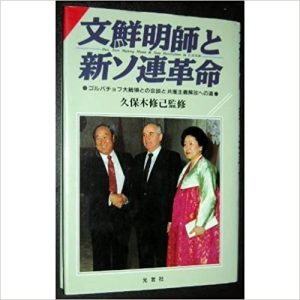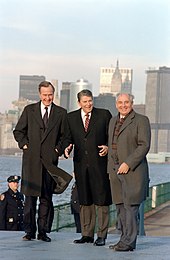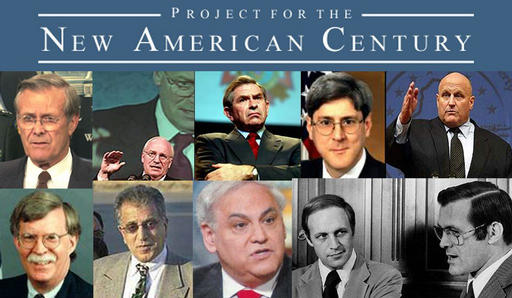The Unification Church is a Korean, Christian-masked CIA-led US political maneuvering groupー. This blog has so far expressed the core of the Unification Church problem. The last Soviet leader, Michael Gorbachev, died on August 30. The Unification Church was involved in the plan to dissolve the Soviet Union by the United States and Britain, and played a role in triggering the attempted coup d'état to oust Gorbachev in August 1991, which was directly linked to the collapse of the Soviet Union in December 1991. This cult, disguised as Christianity, sometimes demonstrated a power that the CIA, which was devoted to behind-the-scenes work, could not do. The Unification Church played a major role in the anti-communist group's ultimate goal of dismantling the Soviet Union, and moreover, provided foundation funds to support all of Gorbachev's activities after he left office. The preconceived notion that the Unification Church was the leader of the anti-communist movement on the Korean Peninsula and in Japan was overturned. Despite this, the Japanese established media is also tight-lipped about the relationship between the Unification Church and the collapse of the Soviet Union.
■ Sun Myung Moon and Gorbachev
 In April 1990, Sun Myung Moon entered the Kremlin and persuaded General Secretary Gorbachev to "recognize freedom of religion and abandon communism." From 1989 to 1990, democratization dominoes occurred in Eastern European countries, and Soviet-style socialism was being abandoned one after another. Gorbachev gave up military intervention in Eastern Europe and accepted democratization.
In April 1990, Sun Myung Moon entered the Kremlin and persuaded General Secretary Gorbachev to "recognize freedom of religion and abandon communism." From 1989 to 1990, democratization dominoes occurred in Eastern European countries, and Soviet-style socialism was being abandoned one after another. Gorbachev gave up military intervention in Eastern Europe and accepted democratization.
When Sun Myung Moon preached, “Abandon communism,” Gorbachev did not say, “Abandon it.” However, Gorbachev set up the Congress of People's Deputies in December 1989, and in March 1990 he had the Congress adopt a multi-party system and a presidential system. In this way, the Stalin-style one-party dictatorship system was virtually abolished in the Soviet Union as well. Gorbachev began to clearly suggest that the goal of his political reforms was a social democratic line, and in 1991, conservatives of the Soviet Communist Party carried out a coup d'état to oust Gorbachev, believing that the Soviet Union was on the brink of dissolution. An unsuccessful event has occurred. At this time, Gorbachev resigned as General Secretary of the Communist Party and dissolved the Communist Party of the Soviet Union.
The United States and Great Britain aroused a sense of crisis among the conservative hardliners of the Communist Party of the Soviet Union, leading them to attempt a coup d'état in August 1991, which triggered the collapse of the Soviet Union in December of the same year. It seems that Sun Myung Moon was the perfect person to increase the distrust of Gorbachev among conservative hardliners who resisted reform. The timing of the visit to the Kremlin was perfect.
So how was Sun Myung Moon sent to the Kremlin?
Sun Myung Moon said, “When I attended the World Press Conference (held in Moscow in April 1990), my attention was focused on meeting with President Gorbachev. Gorbachev was very popular in the country, and I could have met the president of the United States 10 times, but it was a difficult time to meet him.” If this recollection is taken honestly, it would have been impossible for Moon to have a solo interview with Gorbachev unless he had a strong connection.
■Deputy Bush: Road to the Kremlin
According to the testimony of former leaders of the Unification Church in the United States, the Unification Church has financially and organizationally supported the elections of Donald Reagan, George Bush and his son, and Donald Trump, who were elected as Republican presidential candidates. Under these Republican presidents, the relationship between the neoconservatives and the Unification Church, such as Jack Cheney, Donald Rumsfeld, Louis Libby, and Paul Wolfowitz, who rose to the center of power by the 1980s, is also strong. Hidden investment activities in military-related companies such as Halliburton, which Cheney and others were involved in management, are also believed to be done.
President Reagan (1981-1989) was an avid reader of the Washington Times, which is affiliated with the Unification Church, and often sent out important messages through coverage by the newspaper. After receiving a letter from Nobusuke Kishi pleading for the release of Sun Myung Moon, who was detained on suspicion of tax evasion, Reagan is said to have lobbied for his release, although it did not materialize. This suggested how important Sun Myung Moon and the Unification Church were to Reagan's political activities.
In March 1985, Gorbachev became general secretary of the Communist Party of the Soviet Union. With perestroika and glasnost as its slogans, he breathed new life into stagnant Soviet society. At that time, the conservative establishment in the United States and Britain must have laughed coldly. The president of the United States is Reagan, and the vice president is Bush. It was the strongest anti-communist sabotage duo. In 1983, when President Reagan called the Soviet Union an "evil empire," the Reagan administration should have mobilized neoconservatives to create a plan to dismantle the Soviet Union. The perestroika policy allowed the Unification Church to proselytize in the Soviet Union. In the midst of the rapid easing of tensions between the US and the Soviet Union and the end of the Cold War, Sun Myung Moon's path to the Kremlin as Bush's agent was paved.

12/7/1988 New York
 After reading this, the American neoconservatives (photographs) who gathered in Washington seemed to sneer, "How naive!"
After reading this, the American neoconservatives (photographs) who gathered in Washington seemed to sneer, "How naive!" 